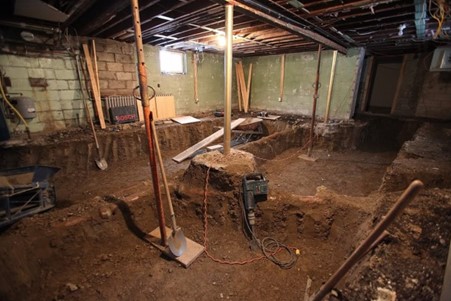Basements and Radon in RBKC- what you need to know.
Geoenvironmental • Regulation
The construction of basements, particularly in London has become more common with the increase in demand for space. The Royal Borough of Kensington and Chelsea (RBKC) have concerns regarding the increased potential for radon ingress.
What is radon?
Radon is a radioactive gas, that is colourless, odourless and tasteless. It comes from the natural rocks and soil found everywhere in the UK. Studies around the world have shown that increased exposure to radon increases your risk of lung cancer.
BRE211 (2015) states that the following:
“All basements are at increased risk of elevated levels of radon, regardless of geographic location”
“Where a new basement is to be created, or an existing cellar converted, waterproofing will be required. A well-constructed waterproofing should be designed to protect against radon also.”
“Guidance and recommendations on basement waterproofing are contained in BS 8102:2009, which also advises that radon be taken into account in the design and implementation of waterproofing schemes.”
The ‘radon potential percentage shown on the freely available UK Health Security Agency (UKHSA) database, is the risk rating for properties at ground level and does not provide an assessment of risk within basements. UKHSA’s work on commercial basements, suggests that there is a far higher potential for radon to effect basements, even in so called non-affected areas. The UKHSA states, within its radon risk reports, that: “The probability result is only valid for properties above ground. All basement and cellar areas are considered to be at additional risk from high radon levels.” RBKC requires developers to follow the advice of the regulators so it considers all basements to be at risk from radon, no matter the allocated radon potential percentage shown on the freely available UK Health Security Agency radon database, UK Radon. Usually, it is recommended that basic radon protection measures are required in areas where more than 3% of houses are at or above the Action Level.
RBKC requires basement construction plans with details of waterproofing and radon protection at the Phase I Desk Study/Intrusive Investigation Method Statement (IIMS) stage. Specifications of the waterproofing/radon protection is required to show that the basement will protect against any potential radon ingress. Therefore, it is advised that if you are considering constructing a basement in RBKC it is worth having this information decided when instructing the Desk Study and IIMS.
RBKC has published its own contaminated land guidance, CLC3. The RBKC CLC3 guidance doesn’t just focus on radon, it also requires developers to consider environmental and historical information, other ground gases and also sets out details of the type of investigation information it might require. This will be applied as a planning condition to applications with the following:
- Construction of a new basement beneath an existing property;
- Extension of an existing basement beneath a property; and
- Refurbishment of an existing basement.
With regard to specifically radon risk in existing basements, the council recommends the following for investigation:
“Where part of an existing basement is to be used as a living area (e.g. bedroom, living room, kitchen diner, etc.), and the construction of the basement does not specifically mitigate against the ingress of radon gas, the measurement of radon gas is required. Monitoring should include at least 1 monitor within each living area with a minimum of 2 monitors being installed within the basement area. If part of an existing basement is to be used as a non-living area (e.g. store/plant room, pool, etc.) monitoring in the basement would still be recommended, alongside monitoring living spaces immediately above. Measuring radon is inexpensive but takes 3-4 months to complete and so it is important to start the monitoring as early as possible. Further details are available on Public Health England’s ‘UKradon’ webpages.”
If the above investigation is not undertaken the following is what the CLC3 guidance recommends to be included within the report:
“The report must demonstrate whether the proposed basement design is resistant to radon gas. Where the basement design is to be used to negate the need for further investigation, full details of the basement design and how it meets the minimum level of protection is required.”
